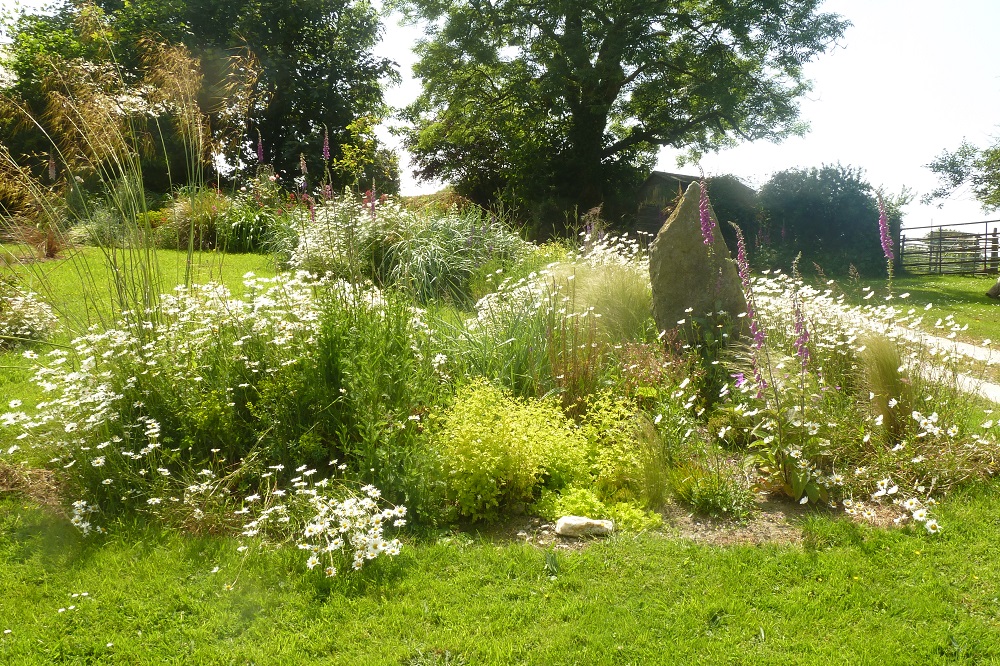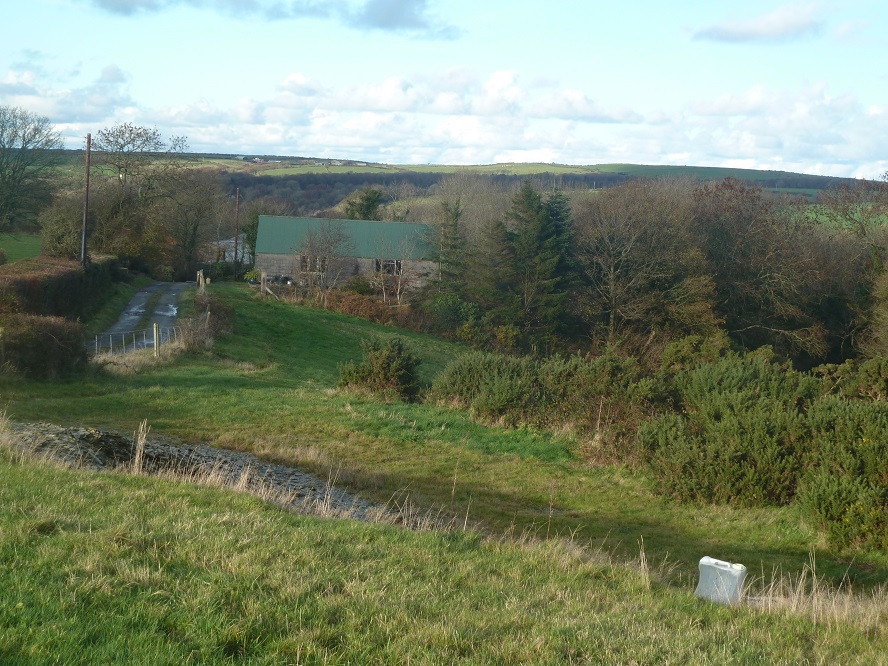Cynefin – A Sense of Place: The Lane part two

Gaynor Funnell
Taking the left turn towards Nevern, I feel I know the essence of this lane now, after all these years of walking along it.
I’m familiar with its twists and bends, know the exact place where you can see the sea between a gap in the hawthorn hedge on a clear day; the way the camber falls to the right on the first left hand corner, eroded by the relentless Welsh rain funnelling through, and on the same bend, how the webs of the spiders soften the spikes of the holly hedge as they abseil between them, only visible when the early morning dew clings to each thread, outlining each one in precise detail; know the spot where the heady smell of evening honeysuckle lies strongest.
How, in early summer, the green corridor running through it becomes studded with the stars of cinquefoil and chickweed.
That around the next corner, where a corner of the field is left to seed, you can smell the grass drying or see the citrine flash of a yellowhammer, and over the next gate where the land lies higher, hear the sunshine-in-a-song call of the skylarks as they rise and fall.
On this late May morning, the sea is a bright, pewter line, the sun august-hot. The cow parsley is shoulder high, touching the almond scented flowers of the hawthorn which drip downwards like icing on a cake and the lane is afroth with white blossom framed against the pale blueness of a sky ribboned with a nectarine blush.
On the northern side of the lane, a few bluebells fade silently, whilst cleaver clambers through woodruff.
The bank which supports the hedge is head-high here which offers a different perspective – some of the plants growing on the almost vertical slope are almost unnoticeable at ground level.
Wood sage is one such plant. Overall, its crinkled and hairy-to-touch leaves are grass-green so the plant is easily overlooked, but close up, the tiny pale yellow flowers with maroon striped tongues resemble miniature snapdragons and they cling tight against the upright, woody stem.
Unlike culinary sage, wood sage has no smell although the insects seem to like it. Just below and free from the confines of the ground, wild strawberry drips red.
Even though a few cars pass through the lane, I can’t resist picking a few berries to eat – all their flavour is concentrated in one tiny mouthful, a miniscule pop of sweetness.
The hedges
Amongst the bracken and pinking sorrel, a wren scuttles. Last July, five hatchlings were near the same spot, trilling and ticking and chittering before I saw them, such a big sound for such diminutive creatures.
They hid and dived amongst the undergrowth, and apart from their cocked tails, resembled insects more than birds. One took a chance and attempted a maiden flight, balancing on a fern frond, which barely moved.
Around the next corner, the hedges are higher and the varieties of flowers less. The hedges are a mix of hawthorn, blackthorn, hazel, entwined with ivy, honeysuckle, dog rose, bramble and old man’s beard.
There’s also an oak, which tries to grow taller every year but is doomed to fail due to the farmers hedge-cutting policy, and a willow, whose olive-green spread is wider than its height, and which loses a few branches every winter, on two occasions blocking the lane.
Mounds of red campion are collapsing into the road. They seem to be the most common flower around here, taking advantage of any available space.
Their flowers are everywhere – the lane, the corners of the fields, the vegetable garden, and some have seeded in my pots that flank the front door. I’ve even see one flowering in December.
The five deeply lobed petals are the colour of candyfloss, and the fairies reputedly use the flowers to protect their honey stores, which is why it’s considered unlucky to pick them. Their Welsh name is Blodyn Neidr, which means snake flower, and the seeds were used traditionally to treat snakebite.

Comma butterfly
Along parts of the lane, red campion, bluebells and cow parsley thread and weave and flower together and how beautiful they look. Nature makes the best arrangements.
In the field where lambs are jostling their mothers for food, a comma butterfly is sunning itself on the fencepost. It’s easy to identify with its jagged wing edges.
When the wings are closed, it resembles a dead leaf – which must be an advantage – and I can just make out the small white comma mark on its hindwing, but when the wings open, they’re a rich orange colour, with tortoiseshell markings.
The comma is a rare example of a butterfly that’s increasing in numbers. Numbers declined drastically when its preferred foodplant, the hop, became less available due to the decline in hop farming.
It adapted its preference by eating nettles, which are widespread, and has therefore been able to spread throughout the country.
It’s a lovely creature and they are one of the most common butterflies on the farm, but the days when you walked through a meadow disturbing clouds of comma, meadow brown and gatekeeper, and when the buddleia in the garden was covered by peacocks, tortoiseshells, and painted ladies are gone.
I get excited to see one butterfly now.

Lambs
I stand and watch the lambs for a while. After years of looking after my own, it’s lovely to watch them play in the sunshine, without worrying about whether they’re getting enough food, if they’re healthy, or if a fox is going to get one.
These are making the most of a small rise in the field, by playing king of the castle. They run and bound, twisting sideways in the air, jumping with all four feet together, race to one side of the field and then the other, their undocked tails wriggling.
The ewes ignore them for a time now – the lambs are big enough and know enough to come and feed when they want to, butting and sometimes almost lifting their poor mothers off the ground, especially when twins feed at the same time.
One ewe calls repeatedly in the corner – it’s the call of a sheep that’s lost her lamb. As they’re not mine, I ignore the urge to climb the gate and look for it. Hopefully it’s one of the lambs in the pack helter-skeltering around the field.
The unique smell of warm sheep; of lanolin, of wool, of dung, drifts over the gate. These ewes will need shearing soon, so flies won’t be able to lay eggs in their wool – maggots can kill a sheep in a day.

Preseli Mountains
I turn away and continue walking downwards towards the road. Here, you can turn left to go to Cardigan town through Glanrhyd, or right to go to the viewpoint, Bayvil and onto Nevern.
Opposite, lies the crenellated ridge of the Preseli mountains, with Frenni fawr rising on the left. Today, they are as clear as if someone had outlined them with a pencil.
The land below rests green after the recent rain, overlaid with darker shadows which chase across the fields, as the clouds scud over the sun.
Gaynor Funnell is the winner of the Nigel Jenkins award for 2022. We are delighted to be publishing a series about Penbanc over the coming months, with support from the H’mm Foundation.
You can read the serialisation so far here
Support our Nation today
For the price of a cup of coffee a month you can help us create an independent, not-for-profit, national news service for the people of Wales, by the people of Wales.






